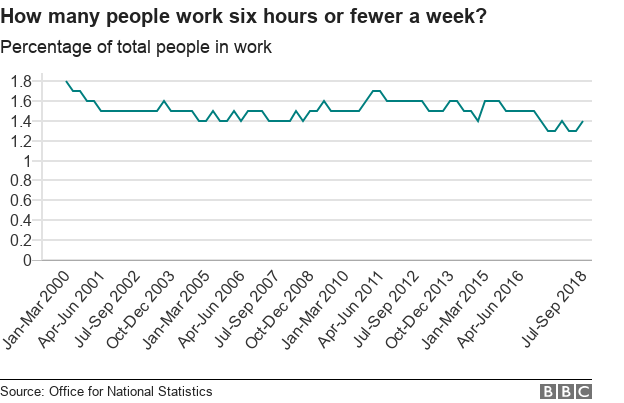Reality Check: Can you be 'employed' for one hour's work?
- Published

Just how many hours do you need to work to be officially classified as "employed"?
Steve Garner, a sociologist, recently tweeted about how his son had repeatedly turned up to work at a warehouse only to be regularly told he wasn't needed.
Allow X content?
This article contains content provided by X. We ask for your permission before anything is loaded, as they may be using cookies and other technologies. You may want to read X’s cookie policy, external and privacy policy, external before accepting. To view this content choose ‘accept and continue’.
Mr Garner's message was retweeted more than 8,000 times. In the replies, several people commented about the employment status of people who worked on zero-hour contracts.
Allow X content?
This article contains content provided by X. We ask for your permission before anything is loaded, as they may be using cookies and other technologies. You may want to read X’s cookie policy, external and privacy policy, external before accepting. To view this content choose ‘accept and continue’.
Allow X content?
This article contains content provided by X. We ask for your permission before anything is loaded, as they may be using cookies and other technologies. You may want to read X’s cookie policy, external and privacy policy, external before accepting. To view this content choose ‘accept and continue’.
BBC Reality Check asked the Office for National Statistics (ONS) whether working just one hour a week was all that was needed to be officially classified as employed?
The ONS confirmed that was the case.
Every three months, a large survey (known as the Labour Force Survey) is sent to approximately 90,000 people, selected at random. The ONS extrapolates the findings to produce employment bulletins.
Those selected to take part in the LFS are interviewed every three months for fifteen months before they drop out of the sample. Interviews are initially done face-to-face and follow-up ones are done by phone. The one exception is the north of Scotland where all interviews are done over the phone because of the distance involved.
A person will need to have worked at least one hour in the week before the interview with the ONS takes place to be classified as employed.
Its most recent survey put the UK employment rate (of people aged 16-64) at 75.5%, external - very close to a record high.
The figures were welcomed by government, with Employment Minister Alok Sharma saying: "The benefits of a strong jobs market are paying off."
But could people working very few hours be artificially boosting the headline employment numbers to make them look better than they really are?
The ONS told Reality Check that was unlikely because the overall number of people working so few hours "is very low indeed".
That is supported by its own figures.

The ONS data, external shows that the number of people usually working six hours or fewer a week is just 1.4% of the UK working population - or just over 400,000 people, which compares with a total of 32.4 million people in work.
In fact, that's a drop from 1.8% at the start of the century.
So, the share of people working very short hours has actually fallen, which suggests zero-hour contracts are not distorting the headline employment numbers.
But why does the ONS use one hour as the definition?
Choosing whether to define someone as being in employment or not can be a bit of a conundrum, says Tony Wilson, director at the Institute for Employment Studies.
"Why pick one hour? Well, because if you put the bar higher, you might end up classifying people as unemployed even though they're working."
"You have to draw the line somewhere," he says.
The ONS definition is also an international one - drawn up by the International Labour Organization (ILO). By choosing to use the ILO's definition, external, the UK's employment data is consistent with other countries, making it easier to draw international comparisons.
UPDATE 21 November: The ONS initially told Reality Check that the criteria to be counted as "employed" was one hour over two weeks. It subsequently told us that it had made an error and that the definition was in fact one hour over one week.

